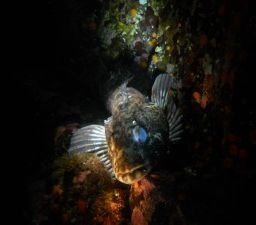If someone asked you to go diving in what used to be one of the most polluted stretches of water in North America, you’d probably say no, right? Well, Britannia Beach near Vancouver, British Columbia used to be just that. Now however, it’s a local diving goldmine.
Britannia Mines shipped their first ore to Vancouver in 1904. Twenty five years later a bustling community had settled in what became the largest copper mine in the British Empire and one of BC’s most historic areas. Throughout the years Britannia saw its fair share of tragedy from rock slides, massive flooding and huge fires, but also prospered through the discovery of zinc, cambium and even gold.
It’s biggest challenge however would come from Acid Rock Drainage (ARD), leaving the near by creeks, groundwater and Howe Sound devoid of life. Thankfully natural ARD associated with heavy mining was capped by the BC Province. Since 2002 the local soils have been cleaned up, and in 2005 a water treatment plant was put into operation, removing up to 700kg of metal sludge from entering Howe Sound every day.
#SDLFact: It only takes two pennies of copper dissolved in a swimming pool to make it toxic to marine life.
We like to think we learn from our mistakes, and in this case, better late than never. At the beginning of 2011 the Vancouver based Shipwreck Exploration and Conservation Society (cunningly abbreviated to SECS), informed the local diving community the waters of Britannia weren’t just divable, but really rather beautiful. The former garbage patch is now home to multiple wrecks, all with a wealth of marine life.
The first dive lays home to the former Coast Guard Cutter Ready as well as a second, smaller vessel, both lying no deeper than 50 feet depth. Swim a mere 160 feet to the south and you’ll discover another, larger wreck that looks to have been sunk sometime around the 1980’s, this one no deeper than 40 feet. Yep, three wrecks in one shallow dive. All covered in a vibrant and healthy range marine life species.
Dive number two, towards the North side of Britannia Beach holds the remains of the SS Joan, a 1892 steam ship. Now little more than a large, wooden overhang protruding from the silt, the remains have become a huge city block for marine life. At 100 feet deep, it makes for an interesting alternative during the low viz summer months of its shallower buddies.
Marine life is abundant. In fact, it seems to be one of the more flourishing local shore dive sites. With schools of shiny perch and tube snout, sizeable ling cod with healthy egg masses, octo’s, nudibranch’s, a bazillion crabs (all doing it!) and enough kelp to encourage more critters to make the wrecks their home.
The marine life at Britannia and the remains of the man’s endeavours make for a poignant and interesting dive. Great for new divers, fantastic for videographers, brilliant for wreck junkies and a lot of fun for anyone looking for a slice of history on a thoroughly enjoyable dive.
Not only a stunning local dive site, but as a microcosm for a global problem, Britannia shows that we can reverse some of the damage we have done. We can clean up our oceans and we can still enjoy them for many years to come.
Who would want to dive in one of North America’s former most polluted areas? Me.
For more information visit www.secsociety.com/britannia


